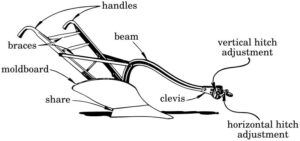Farmers who migrated to the Midwest from New England found the soil to be very different from what they were used to. The soil here was a sticky loam. Using a small team of horses and wooden moldboard or cast-iron plow, most farmers were lucky to plow just eight acres by the end of a plowing season. Progress was slow because they had to stop and use a wooden paddle to scrape the soil from the plow every few steps. If only a plow could be devised that would prevent this!
Did You Know?

Parts of a Plow Courtesy of wpclipart.com
In 1837, Deere had an idea that would change farming forever. He took a broken steel saw blade, cut off the teeth, and then heating one small section at a time, molded it into a combination moldboard and share. The addition of this steel piece reinvented the plow into a tool that could cut through prairie grass without clogging or dulling.
Deere’s steel plow gave farmers the chance to work more land and make a healthy profit. In 1840 Deere produced 40 plows selling them for $12 each. In 1843 he sold 400 plows and now listed his occupation as an agricultural manufacturer rather than a blacksmith.

Image Courtesy of John Deere Archives

